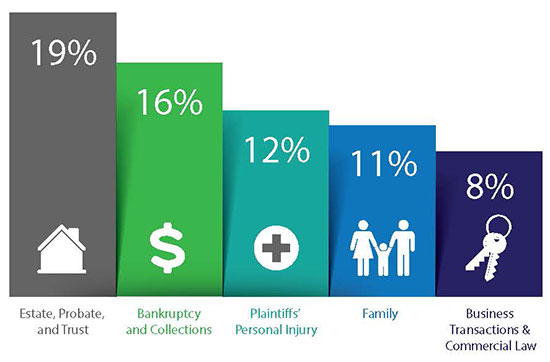
So here we are – a new year. A fresh start! Finally.
Now that the new year is in full swing, it’s a great time to think about how to improve your law practice. How can you best serve your clients, reduce your risk of mistakes, and avoid a malpractice claim or an Office of Lawyer Regulation (OLR) complaint? It’s time to learn and move on from the challenges and adversities of 2020.
WILMIC’s 2020 Claims Data
From a risk-management perspective, the best way to improve your practice procedures is to take a look back at the prior year’s claims data to highlight the areas of practice that placed lawyers at the greatest claim risk, says Brian Anderson, senior claims attorney at Wisconsin Lawyers Mutual Insurance Co. (WILMIC). It can also be helpful, he says, to see which types of mistakes resulted in legal malpractice claims.
Anderson says, “One of the concerns that we had this past year is how the COVID-19 pandemic would impact practitioners from both a claims-frequency and severity standpoint. We anticipated an influx of legal malpractice claims in 2020, as both lawyersand their clients faced unanticipated challenges impacting all aspects of their lives and their business operations. Fortunately, this was not the case in terms of the frequency of legal malpractice claims reported last year. WILMIC saw a dramatic decrease in new claims reported to the company in 2020, the lowest number of reported claims in 20 years.”
While the claims-frequency numbers were encouraging, Anderson says, there was an increase in the severity (that is, the dollar amount) of new claims reported in 2020. “This increased exposure facing insured lawyers was noted both in new claim matters reported as well the development of open claims that were previously reported to the company. It is unclear, however, if this increased-severity trend is related to the pandemic, as legal malpractice claims often take several years to fully develop.” Anderson adds that the increase in severity bears watching as we move into 2021 and beyond.
Getting the new year off to a good start can go a long way toward a successful and prosperous 2021. A review of the 2020 malpractice claims that came into WILMIC may help you determine how to improve your practice in 2021.
Frequency. The five practice areas that produced the most claims in terms of frequency in 2020 were the following:
- Estate, probate, and trust – 19 percent
- Bankruptcy and collections – 16 percent
- Plaintiffs’ personal injury – 12 percent
- Family law – 11 percent
- Business transactions and commercial law – 8 percent
Severity. In terms of severity, the five areas of practice at the top of the list were the same, although in different order:
- Plaintiffs’ personal injury – 33 percent
- Estate, probate, and trust – 21 percent
- Business transactions and commercial law – 17 percent
- Bankruptcy and collections – 10 percent
- Family law – 8 percent
Anderson says that these five practice areas have historically been among the most likely to experience claims, so nothing new there, although real estate practice fell out of the top five last year for the first time in a while.
From a risk-management perspective, it is always interesting (and, I hope, helpful) to drill down into the areas receiving the most claims to examine what may have prompted a claim and what you can do to minimize the risk in those areas in 2021. Here’s a look at the practice areas that produced the most claims.
WILMIC’s Top 5 in 2020

A review of 2020 malpractice claims may help you determine where you might want to improve your practice in 2021. The practice areas shown were WILMIC’s top five in terms of claims frequency.
Estate Planning
Estate, trust, and probate practice, at 19 percent, generated the highest percentage of claims in 2020. Anderson says the nature of the claims varied. “We opened several claims last year that were asserted against attorneys involving the alleged failure to properly manage, oversee, and timely administer pending probate matters. Another issue leading to claims in this area of law was the alleged failure to timely communicate with the decedent’s heirs to an estate, resulting in a general dissatisfaction with counsel and claimed conflict concerns. This problem has manifested itself in both claims and grievances asserted against the lawyer.”
Anderson adds that disinherited beneficiaries complaining that an attorney failed to accomplish the decedent’s intended distribution continued to be a source of claims against estate planning lawyers. He says, “Lawyers practicing in this area of law are under an increased time pressure, and the perceived failure to timely handle and execute their client’s estate planning matters could result in additional claims going forward.”
Bankruptcy, Collections, and FDCPA
The second most common source of claims brought in 2020 was bankruptcy, collections, and Fair Debt Collection Practices Act (FDCPA) work. This continues the trend that WILMIC has observed in this practice area over the last several years. Anderson says, “The most typical type of claim reported to WILMIC last year in this area of practice continues to be ‘first notice lawsuits’ filed against the collection attorney for allegedly violating the FDCPA and Wisconsin Consumer Act. Although this risk resulted in claims, we observed a steady decrease in the overall severity of these types of claims in 2020. Attorneys acting as receivers in bankruptcy matters were also targeted with claims last year, alleging that they acted improperly in securing assets to be included in the bankruptcy estate. We are monitoring the impact that the increased activity in the areas of bankruptcy and collection practices may have on legal malpractice claims going forward.”
Anderson says this is one area in which the pandemic might have an effect. “This risk will likely be exacerbated by the ongoing COVID-19 pandemic as consumers and small-business owners are facing significant hardships that will continue into the foreseeable future.”
Plaintiffs’ Personal Injury
Attorneys who represent plaintiffs in personal injury matters generated the third highest number of claims last year. Anderson says plaintiffs’ personal injury practice claims remain by far the most expensive to resolve in terms of severity since WILMIC started doing business in 1986.
According to Anderson, “Missed statute-of-limitation issues was the source of the most claims impacting lawyers practicing personal injury law in 2020. In addition to the failure to timely file an action within the appropriate time period, we opened claims involving the failure to timely serve an action after it was filed and the failure to comply with the court’s scheduling order in terms of naming experts, responding to counterclaims, and pursuing potential third parties in a timely manner.”
Anderson notes, “We are also monitoring several claims reported in 2020 where the lawyer was second guessed for the general strategy employed and the overall handling of the underlying personal injury claim, [which] was either settled or tried. These ‘inadequate settlement’ type of claims can present a significant exposure to the attorney. From a severity standpoint, legal malpractice claims in the bodily and personal injury area were the most expensive to defend and resolve last year, representing one-third of all of the claims expense incurred.”
Family Law
Family law work generated the fourth highest number of claims for WILMIC last year. Claims asserted against lawyers practicing family law primarily involved clients who were not satisfied with the final division of property at the conclusion of a divorce.
Anderson says clients’ dissatisfaction came as a result of several different issues. “Whether the attorney should have retained an accounting expert, drafted a more airtight marital property agreement, or better communicated the pros and cons of allowing the court to determine the final financial outcome of the divorce have all resulted in dissatisfied clients and ultimately claims. It is entirely possible that the source of these claims could be fueled by economic pressures impacting the client that were not contemplated by the attorney when the underlying divorce case was being resolved.”
Another component of these family law claims involves fee issues between lawyers and clients. “The source of these fee-related issues appears to be a lack of understanding regarding the billing process and a general disconnect in the overall communication between the lawyer and the client regarding the fees,” Anderson says. “When the client is left with a substantial outstanding fee and may not have received the outcome they anticipated, a fee dispute or grievance is often the result.”
Business Transactions and Commercial Law
Business transactions and commercial law round out the five areas of law that generated the most claims for WILMIC last year. Anderson says not only did this area of practice jump onto the list of five most frequent claims areas, but it also had an effect on WILMIC’s indemnity paid out for claims.
Lawyers were dragged into claims involving failed business disputes, after their clients’ transactions fell apart.
“Of greater concern here is the fact that this area of practice represented over 17 percent of the indemnity dollars paid to resolve these types of claims last year,” Anderson says. “Lawyers were dragged into claims involving failed business disputes after their clients’ transactions fell apart. A common theme in these types of claims is that the attorney was frequently the only lawyer involved in the underlying business transaction, for both sides. This type of arrangement helped set up a conflict-of-interest legal malpractice claim in which the aggrieved party, client or not, blamed the lawyer for not better protecting their interest, or more clearly defining whom they represented at and before the closing. These types of claims will likely continue to be asserted against practitioners, with many small-business clients facing hardship and financial stress. The business transaction attorney may be viewed as the best source to recover damages after a business has failed.”
2020 Conclusions and 2021 Resolutions
As we move away from 2020 and the pandemic slowly comes to an end, lawyers who follow certain risk-management strategies can thrive.
Anderson says it was clear in 2020 that the legal profession can and will continue to serve clients well. “According to the 2020 legal malpractice claim information, lawyers insured by WILMIC persevered last year and by all accounts enjoyed a successful year in terms of the number of new claims reported.”
Anderson’s advice for new year’s resolutions is simple. “Careful, frequent, and detailed communications with your clients is manifest heading into year two of the pandemic as economic pressures will continue to mount. Addressing conflict concerns before an issue presents is the best way for a lawyer to avoid a claim or grievance down the road. Finally, developing a clear scope of retention that is understood by your client and that is documented in writing is also vital. These risk-management tips can both help you avoid or defend any legal malpractice claim asserted in 2021, and it represents great client customer service to your clients for the new year.”
